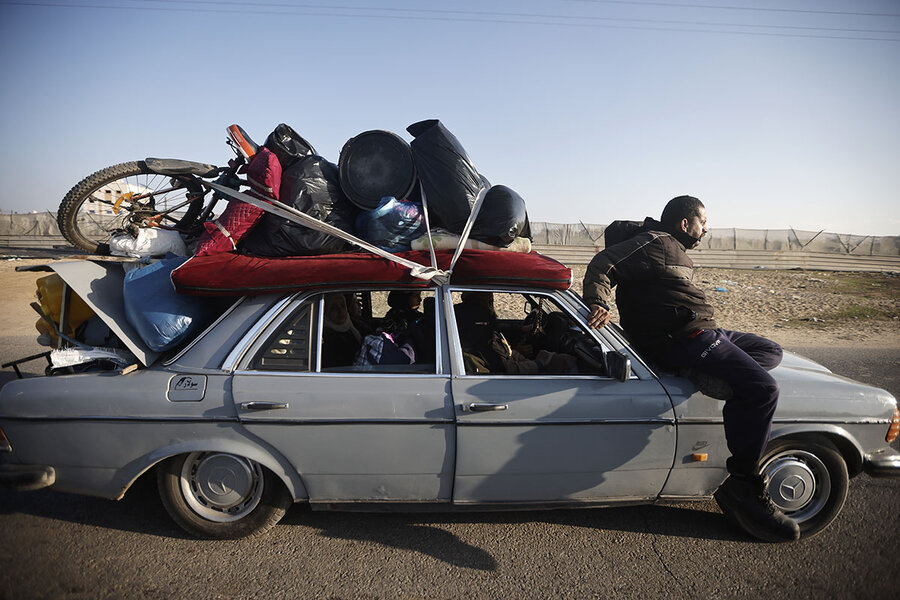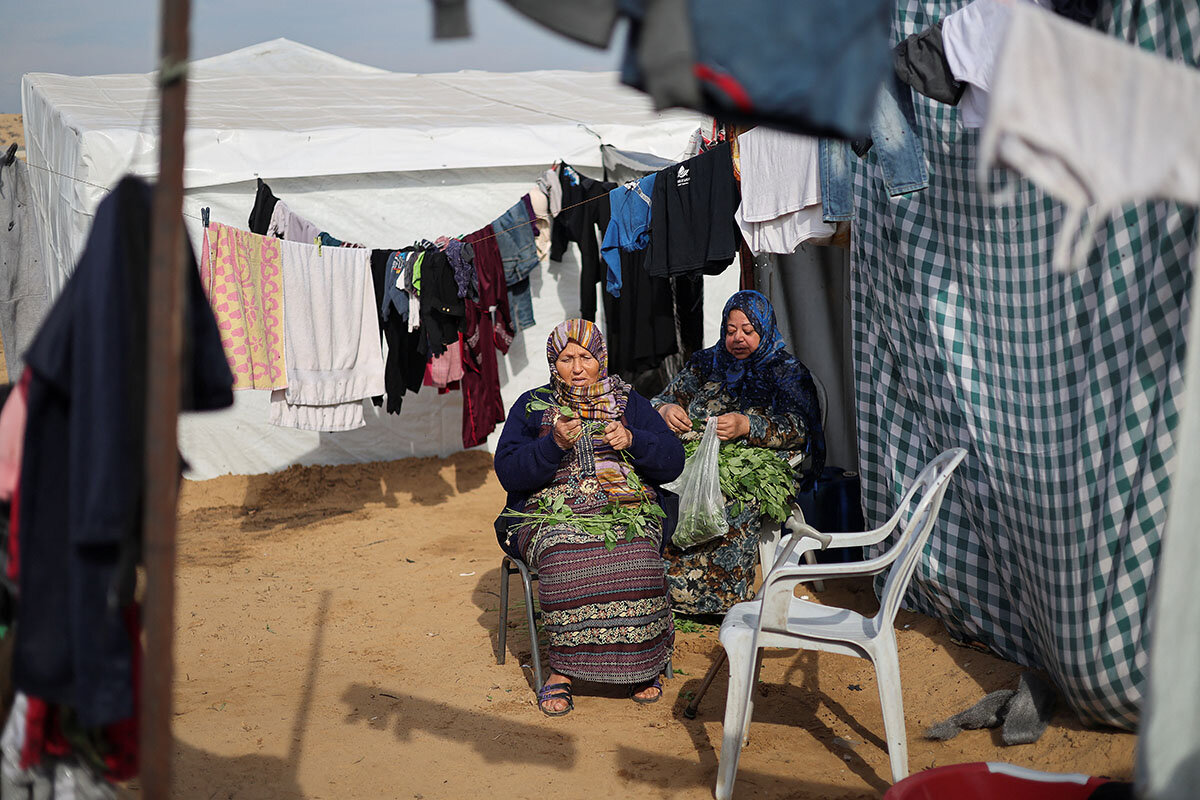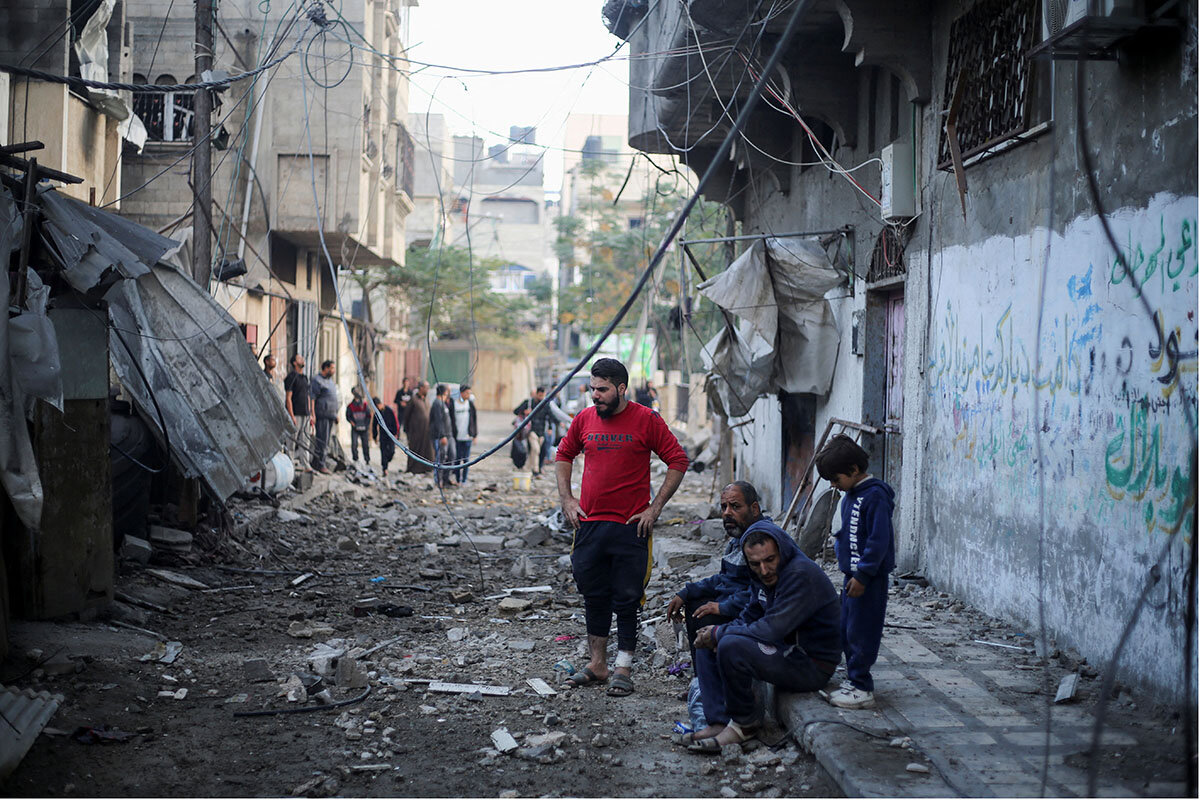‘The ground is shaking’ in southern Gaza. Is anywhere safe?
Loading...
| Rafah, Gaza Strip; and Dubai, United Arab Emirates
As Israel’s military campaign pushes further south in Gaza, and Israel and Hamas engage in urban warfare, Palestinian residents say they are left with nowhere to go.
Reeling from the dashed hopes for an extended cease-fire, Gaza Palestinians say they are now under siege like never before – isolated from family members they can no longer contact and trapped in a rotation of neighborhoods as the Israeli army’s push cuts off one residential block from another.
With the Israeli army dropping evacuation order leaflets in Khan Yunis and elsewhere in southern Gaza – to which Israel instructed 1.2 million people to evacuate at the start of the war – Gaza Palestinians no longer know where to turn, where to find shelter, or if they will survive the night.
Why We Wrote This
A story focused onIsrael is being pressed to protect Palestinian citizens as it battles Hamas. But its efforts to direct people in southern Gaza to safe zones are proving confusing and hard to access. Everywhere are bombs and bullets. There seems nowhere to go.
In the southernmost town of Rafah, dozens of displaced families and individuals are living in the streets, scrambling for makeshift shelter as Israeli drones buzz overhead.
As of Thursday, Israel’s military campaign in Gaza had displaced 1.93 million Palestinians, or 86% of the strip’s population, according to the United Nations, and killed more than 17,000 people, Gaza officials say.
On Friday the United States vetoed a U.N. Security Council resolution, sponsored by the United Arab Emirates, demanding an immediate humanitarian cease-fire. The vote on the resolution was 13 to 1, with Britain abstaining.
In southern Gaza, shelter is extremely scarce.
At Rafah’s Duwwar Al-Awda roundabout, or “circle of return,” located 500 yards from the Egypt-Gaza border, dozens of men, women, and children resorted to lying on collapsed cardboard boxes on the street under the open sky. They clutched themselves, hoping that no artillery shelling or airstrikes hit nearby.
At the UNRWA flour distribution center in Rafah, thousands of people stood outside Friday waiting to get a 25-kilogram sack of flour. But the United Nations said its aid distribution has halted in the rest of the strip.
Complicating matters: Communications are down in large swaths of southern Gaza as part of Israel’s military campaign, adding to the worries of families split up and spread out across the southern half of the coastal enclave. Most do not know the fate of their children, parents, or siblings just a few miles away.
The epicenter of the fighting, bombardment, and chaos is in Khan Yunis, where Israel’s ground operation entered its eighth day since the collapse of the cease-fire, and where Israeli forces engaged in house-to-house combat with Hamas. Khan Yunis is the hometown of Hamas leader Yahya Sinwar, and Israel says Hamas officials and battalions are based in tunnels beneath the city.
“We can’t sleep; my hand shakes”
Reena Abu Nahla and her two children were among the thousands caught in the fighting and unrelenting bombing in eastern Khan Yunis.
They had returned to their family home in the Maan neighborhood of Khan Yunis on the first day of the cease-fire late last month in the hopes the lull in fighting would last and they would remain relatively safe.
Now the ground beneath them quakes nonstop, and explosions nearby have continued since the first airstrike in the area minutes after the cease-fire collapsed last Friday.
“The ground is shaking; there are nonstop airstrikes. We can’t sleep; my hand shakes,” Ms. Abu Nahla says. “I hold my two children in my lap at night. Every time there is a loud explosion, I hug them tightly.”
At night, Gaza’s skies turn red and orange as if on fire. “The smell of gunpowder is very strong; it is everywhere. There are nonstop rings of fire,” Ms. Abu Nahla says.
As part of its southern campaign, and amid U.S. pressures to reduce the number of civilian casualties, the Israeli military published on its website and social media channels a map dividing the enclave into 600 numbered blocks. It told Palestinians in Gaza to follow updates from its social media channels on when to evacuate the numbered blocks, creating confusion among Gazans – even those very few able to read the map.
Due to electricity supply cuts and communication network outages imposed by the Israeli military, the vast majority of Gaza residents are without internet access and unable even to see the detailed map. The few that are say the tiny blocks and digits are difficult to read and do not always correspond to geography.
“I managed to connect to the internet ... but I saw people on the street running and moving desperately,” not knowing where to go, says Hend Abu Aisha.
The Israeli army’s maps do not indicate clear safe zones or areas for evacuees to head to.
“This is the third time”
Ms. Abu Aisha, from northern Gaza, received an airdropped leaflet to vacate her parents’ home in the Khan Yunis neighborhood of Al Qarara, where she had just arrived seeking refuge during the cease-fire. The leaflets described the area as a “conflict zone.” It was her third displacement since the war began.
A few hours after her family evacuated the neighborhood, Israeli forces began an intense bombardment of the area, flattening residential buildings and killing dozens.
“This is the third time. I feel hopeless and helpless,” she says, “I feel like we are being humiliated.”
Workers at Dar al-Salam Hospital report gunbattles between Hamas and the Israeli army, and Israeli snipers firing shots into the hospital, preventing emergency workers from carrying out their work or treating patients.
“In the hospital we are walking on carpets of bullet shells,” says one nurse at Dar al-Salam Hospital.
Another center of the fighting is Deir al-Balah, which up until the Israeli southern campaign had been among the least-hit towns in Gaza. On Sunday, as Israeli forces approached and began to encircle Deir al-Balah after the cease-fire collapsed, Om Rizq Safi, a woman in her 50s, left her hometown.
Her family narrowly avoided incoming Israeli tank columns as their driver took a series of side streets and alleys, zigzagging east and west to finally get them south to Khan Yunis.
Ms. Safi, her sons, and their wives and families – a total of 20 people – sought refuge at her sister-in-law’s house in central Khan Yunis. Within three days the Israeli military dropped leaflets on the home and surrounding area ordering residents to evacuate.
Ms. Safi was forced to pick up once again, carry mattresses, and move further south, although she has nowhere to go.
“I am scared that the conditions are becoming increasingly dire. I do not know what will happen,” she says, saying the plight echoes the Nakba, the violent displacement of Palestinians during the 1948 Arab-Israeli war. “My parents told me about the atrocities of 1948, but I don’t think it’s the same. It is worse.”
Two of Ms. Safi’s adult sons and their families remain in Deir al-Balah. She has lost communication with them since last Friday.
Her last words to them: “I told my children, ‘If we are meant to live and meet each other again, we will.’”








